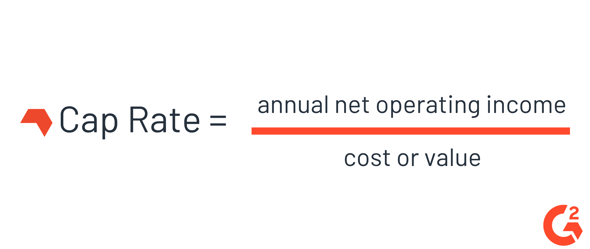The primary goal of investing is to end up with more money than you started with.
As it turns out, this is a lot easier said than done. When you choose to invest, you’re taking a risk and hoping for a good outcome. And while hoping for a positive outcome is good, finding a way to predict that outcome is even better.
When it comes to real estate, owning investment properties can be very lucrative. At the same time, the real estate market strongly fluctuates throughout each season, making it difficult to predict. To help mitigate this risk, real estate professionals use a formula called cap rate.
Cap rate definition
Cap rate, short for capitalization rate, is a metric used in real estate to evaluate the potential return on an investment property. The higher the percentage, the higher the potential risk.
In this article, we’ll talk through cap rate more in-depth, share how to calculate it and discuss what a good rate is.
What is cap rate in real estate?
In short, cap rate is used to measure the return on real estate investment properties. When you’re considering multiple properties, it allows you to compare their earning potential at a glance. It also indicates how long it will take to recover the entire investment.
While the rate is a useful tool for evaluating risk, it’s meant to be used as an estimate since there are many factors that can affect its accuracy. This will be one among many things to consider before fully jumping in on an investment property.
How to calculate cap rate
The formula is straightforward and painless. To calculate cap rate, you take the net operating income (NOI) of the property and divide that number by its value. To get the final percentage, multiply by one hundred.
 The net operating income is a measure of how much income a property is able to generate. It’s a pre-tax figure that accounts for maintenance and other operational costs.
The net operating income is a measure of how much income a property is able to generate. It’s a pre-tax figure that accounts for maintenance and other operational costs.
The value refers to the price of the property. This number should include any applicable acquisition costs such as the brokerage or closing fees.
For example, say that a property is listed for $5,000,000 and generates an annual NOI of $1,000,000. The cap rate for this building would be 20 percent. At this point, you might be asking: what does this percentage mean? We’ll go over that next.
What is a good cap rate?
Calculating cap rate is pretty simple. The hard part is making sense of the percentage and what it means. That being said, there is no set rule that determines a cap rate as being good or bad. Most industry experts agree that 10 percent is a good benchmark for an ideal cap rate. However, plenty of investors have luck buying below or above that rate. It all comes down to preference.
It’s important to note that the higher the cap rate is, the better your ROI will be. A higher cap rate also means there is higher probability of risk associated with the property. On the other end, a low cap rate indicates a lower level of risk and profitability.
Understanding cap rate
When it comes to investing in real estate, very few things are for certain. Cap rate will give you a good idea of the risk associated with buying a property, but there are no guarantees. You’ll have to weigh out how much of a risk you’re willing to take, and account for external factors such as the type of property, location and market trends.
|
TIP: Real estate asset management software provides investors with more advanced insight into investment risk and liability. To explore asset management tools and learn more, head to G2.

|
The big picture
At the end of the day, cap rate is just one piece of the real estate puzzle. You shouldn’t invest your money in a property solely based on its cap rate. However, there’s no doubt that you should take it into consideration to make as informed of a decision as possible. You can’t predict the future with just an equation, but you can come close.
 by Izabelle Hundrev
by Izabelle Hundrev
 by Izabelle Hundrev
by Izabelle Hundrev